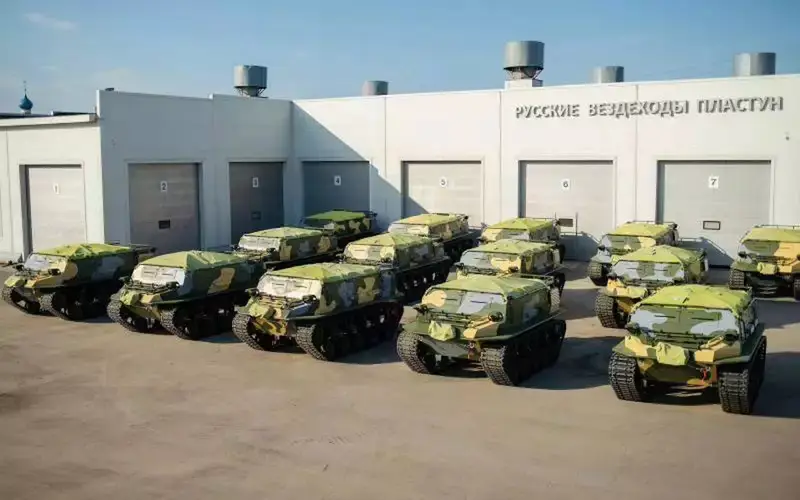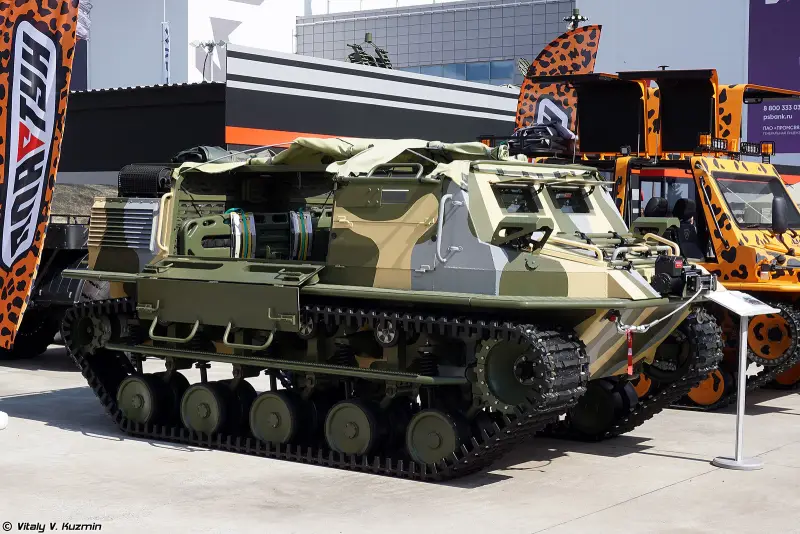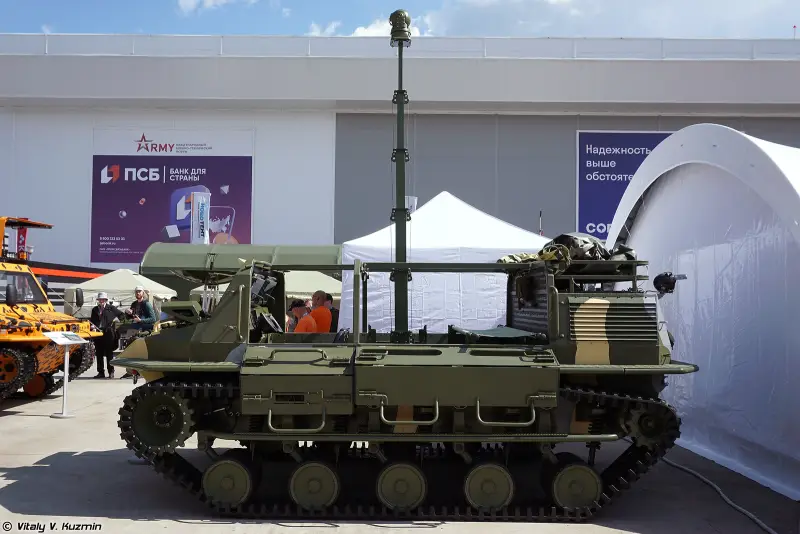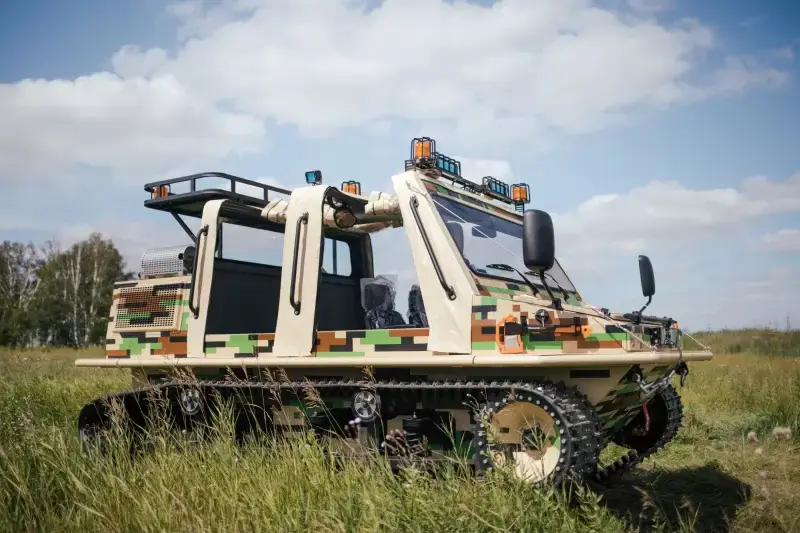All-terrain vehicles "Plastun-SN" are being tested in the Special Operation zone

All-terrain vehicles "Plastun-SN" at the assembly shop. Photo "Russian all-terrain vehicles "Plastun"
The Russian army receives and tests various new types of equipment in the combat zone. The next model being tested in difficult conditions was the domestic multi-purpose tracked transporter “Plastun-SN”. It is made on the basis of available components and has fairly high technical characteristics, and is also capable of transporting various cargoes or carrying the necessary weapons.
Family member
In 2021, the Russian All-Terrain Vehicles Plastun company (St. Petersburg) presented its first tracked transporter intended for use by civilian customers. Subsequently, several modifications of it were created with certain features, intended for different structures and areas of application.
Not long ago, the Plastun development company paid attention to the needs of the army and began developing a specialized version of the all-terrain vehicle for the armed forces. The resulting special-purpose transporter Plastun-SN was first shown several months ago, in August, at the Army-2023 military-technical forum.
The new Plastun-SN product was demonstrated both as an independent platform and as a carrier of special equipment and weapons. They showed the possibility of installing reconnaissance equipment and mortar weapons. It was also reported about the possibility of transporting personnel, wounded, etc.
It was assumed that an all-terrain vehicle of this kind would be able to interest the army and find its place in its equipment parks. However, over the next few months, precise information of this kind was not received. In the fall, fragmentary data appeared about the possible presence of “Plastun-SN” in the Special Operation zone, but they did not receive proper confirmation. Moreover, foreign resources with an ambiguous and dubious reputation even reported the destruction of such an armored vehicle.

Transporter "Plastun-SN" at the forum "Army-2023". A uniform civilian pattern is visible in the background. Photo Vitalykuzmin.net
Official information about the arrival of Plastun-SN all-terrain vehicles to parts of the Russian army appeared only a few days ago. On December 15, this was reported by the Izvestia publication with reference to the head of the Moscow representative office of the company “Russian all-terrain vehicles “Plastun” Anton Martynyuk.
According to him, multi-purpose all-terrain vehicles are present in the operation area and are used to evacuate the wounded. At the same time, the number of vehicles at the front, the features of their operation, etc. not ready to reveal yet. Apparently, they are undergoing military tests using a limited amount of equipment. Based on their results, the Ministry of Defense will have to decide whether it needs such machines.
Maximum unification
The Plastun-SN multi-purpose all-terrain vehicle is a lightweight tracked armored vehicle capable of carrying various loads. Its design uses newly developed units and products available on the market. This approach made it possible to simplify the design, production and operation to a certain extent, and also provided fairly high performance.
The army version of the Plastun is built on the basis of a welded armored hull. The body is assembled from sheets of different thicknesses, providing protection levels Br3 and Br4 according to the domestic standard. All-round protection against machine gun bullets and shrapnel with close energy is provided. The frontal projection can withstand fire from non-armor-piercing rifle bullets.
The case has an interesting design. Its lower part is made in the form of a “bathtub” with the necessary units; chassis elements are attached to it from the outside. On top of the bow there is a frontal shield with armored glass, covering the driver and commander. The sides are made of several movable sheets: for ease of landing and loading, they can be folded to the sides. There is no metal roof; Instead, a quick-release awning is used.

All-terrain vehicle with optical reconnaissance equipment. Photo Vitalykuzmin.net
The all-terrain vehicle is equipped with a power unit manufactured by AvtoVAZ. One of the common gasoline engines with a volume of 1,6 liters and a power of 106 hp is used. It is connected to a five-speed manual gearbox. In the bow of the hull there is a turning mechanism based on side clutches that provide torque to the front drive wheels.
“Plastuns” have two versions of the chassis with maximum unification. The military version with the letters “CH” receives a tracked propulsion unit with five road wheels on board and an individual spring suspension. Rubber caterpillar tracks with increased strength and wear resistance characteristics are used.
The machine has a length of approx. 4,7 m with a width of less than 2,5 m and a height of 2,15 m. Curb weight - approx. 3,8 tons. On a hard surface, the all-terrain vehicle reaches speeds of up to 50 km/h. The wide track reduces ground pressure and allows you to move on soft surfaces, sand or snow. Like other all-terrain vehicles of the family, Plastun-SN can float by rewinding its tracks.
Payloads
Most of the internal volumes of the hull are given over to the passenger cabin. In its front part there are two seats for the driver and commander. The control station is built according to automotive standards: there is a steering wheel of a traditional design, as well as a set of levers and switches. It is expected that this will make it easier for drivers to master the technology. The central part of the hull accommodates up to six seats. Various types of payloads can also be installed at this location.
Reportedly, during the Special Operation Plastun-SN are used as ambulance transport. The specifics of this application are not specified, but it can be assumed that the vehicle can simultaneously transport up to 2-3 lying wounded on stretchers. Seated up to 5-6 people, in turn, can ride on standard seats.

One of the variants of the civilian "Plastun". Photo "Russian all-terrain vehicles "Plastun"
At Army 2023, more complex options for using the platform were demonstrated. Thus, the all-terrain reconnaissance vehicle received a telescopic mast 7 m high with an optical-electronic station on top. In the cabin, accordingly, control and video signal output equipment is installed. The dimensions of the passenger cabin allow it to accommodate an 82-mm mortar, its crew and ammunition. In this case, shooting can be carried out directly from the vehicle, and its units can cope with such loads.
Other options for equipping the all-terrain vehicle are quite possible. It can carry cannon or missile weapons, various surveillance and communications equipment, etc. It can be used as a light patrol or reconnaissance vehicle, etc.
Design potential
In general, the appearance in units of a new type of equipment capable of solving several important problems should be considered a positive event. New all-terrain vehicles in one way or another help units solve combat and auxiliary missions, and in addition, experience is gained for their further improvement. At the same time, the main advantages and disadvantages of the new Plastun-SN are already clear.
The strengths of this all-terrain vehicle include a good balance of tactical and technical characteristics and simplicity. The design widely uses ready-made units, and new elements are not complicated. The key solution of this kind is the use of a power plant from AvtoVAZ. Purchasing a serial engine and gearbox for the production of all-terrain vehicles will not be difficult. The operation and repair of such units will also be somewhat simple.
With all this, sufficiently high running parameters and load capacity are ensured. In addition, the vehicle is capable of carrying different loads and equipment. Four uses of the rover have already been shown, and more are to be expected. Their number is actually limited only by the characteristics of the carrying capacity and the needs of the operators.
However, there are also disadvantages. The military version of the Plastun all-terrain vehicle received armor, but it corresponds only to the Br4 class. This sharply limits the use of the vehicle on the front line due to the risk of damage from enemy actions. The lack of an armored roof is also a reason for criticism. This design feature simplifies loading, but at the same time contributes to the emergence of additional risks - especially when the enemy actively uses various UAVs. Perhaps, based on the experience of current operation, the all-terrain vehicle will be equipped with a full roof and a protective “canopy” over it.
Thus, the Russian industry has created another quite interesting and promising model of armored vehicles. It has strengths that should help in solving problems, but it is not without its shortcomings. Right now, the new Plastun-SN all-terrain vehicles are undergoing military tests in the Special Operations area and demonstrating their potential. Based on the results of these events, it will be decided whether such equipment will be adopted for service and, if so, in what form.
Information